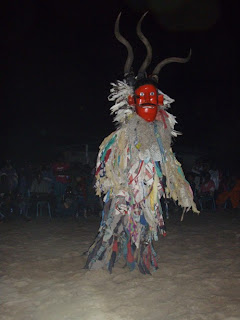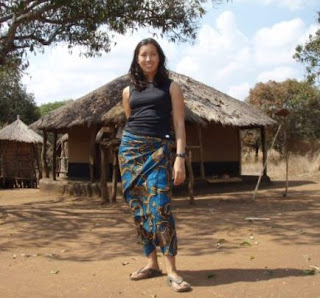I was invited to spend Christmas this year with my housemates. I initially assumed that they would be spending Christmas with their parents and the rest of their family, so I had expected to be a part of some large family gathering at their parents’ home in a town near the Zambian border, an hour and a bit outside of Lilongwe. However, I soon found out this was not going to be the case. In fact, the plan was to spend Christmas at the lake with some friends.
In the afternoon of Christmas eve, my housemates Khala, Bon, and I got picked up by a minibus that was rented by Khala’s friend Isabel. The minibus was packed to the brim with people (a number of Isabel’s siblings and cousins were also joining us), lots of luggage and food, as well as extra mattresses and a braii.
We stayed at a place called the “Beach Villa” which was actually a complex of 20 or so “villas” (which make them sound fancier than they are . . . they were really just 2 bedroom cinderblock chalets) by the beach. There were 12 of us and we took up two of the chalets. We set up the braii (bbq) and so started a weekend filled with meat. It seemed like that braii was constantly loaded up with piles and piles of chicken, beef, or sausages. Not a vegetable or carb to be seen! I came prepared with a package of my trusty soya pieces so I made my own supper that first night.
On Christmas eve evening we sat by the lodge eating, drinking, and listening to really loud music when someone informed us of a performance of gulewankulu (big dance). The Gulewankulu is an important traditional dance here, performed by “chilombo” or “moving spirits” who dress in masks and costume. No one has been able to give me a satisfactory answer as to what these moving spirits do exactly, but they are from the rural areas and dance at functions and celebrations, and otherwise just run around and cause mischief. If you’re not careful and especially if you disrespect them in some way, they may put a curse on you – so watch out! They also perform their dances for general spectators, such as what was happening by the lodge.
A large crowd gathered by the beach where the performance was taking place. The place we were staying at was filled with Malawians and I was the only Muzungu there, and in the crowd of spectators. The musical accompaniment was provided mostly by 5 or so drummers, who used wooden dug out drums with goat skin – they would frequently tune their instruments by placing the drum in the flames of a fire. The chilombo wore costumes ranging from a woman’s dress (though the dancer was more than likely a man), to coveralls, to big smocks covered in scraps of various fabrics. The masks ranged from being very plain to being huge and elaborate. The dancers went up one at a time (there must have been around 10 in total) and all had different styles, mostly depending on their costume - some were lots of hips, others lots of twirling and rolling around in the sand, and one danced with fire while another wore stilts. People in the crowd could go up and give the dancers money and then get them to do something for them. Typically they might want them to do some particular dance move, or dance with them, or have a photo taken. One little girl, who couldn’t be over the age of 7, went up and seriously busted a move in a dance off with one of them, and the crowd roared in approval. Someone I was with, without my knowing, gave one of them money to take a photo with me, so all of a sudden I had a crazy dressed dude come barreling towards me and pull me towards him for a photo op – I was slightly mauled but the crowd certainly l loved it!
Once the show (which went on for at least a couple of hours) was done, we returned to the braii for yet more meat (I must admit to feeling a little left out!). All of a sudden we heard screams coming from nearby, followed by a herd of running children coming tearing past us. I went over to investigate the situation. Turns out, a black mamba snake (well, that's what I was told it was - they are quite poisonous apparently) had slithered into one of the chalets, in pursuit of a toad that had hopped inside. A group of men wielding pieces of PVC pipes came to take care of the situation. The snake was hiding under a bed so then men proceeded to jab it to near-death and then triumphantly came outside with the snake dangling at the end of the stick. The crowd shouted out instructions for them to chop its head off – the only proper way to do away with a poisonous snake apparently. So, they proceeded to chop the snake’s head off with a stick.
The next day was filled with swimming and barbequing. I bought some fish (fisherman just wander around the beach and up into the lodges with bunches of fish tied with string for sale) so I got to participate in the festivities a little bit more which was nice!
The dancers returned so we watched a few more performances – one of the dancers had a remarkably santa claus like mask on, the closest I came to seeing Santa on Christmas this year!
In the afternoon we headed over to the nearby Livingstonia beach hotel campgrounds. We packed up the braii and set ourselves up right by the beach. It was quite a nice place, and absolutely hopping, filled with people. So, we spent the rest of Christmas swimming and eating. I received many phone calls from home, which was very nice!

Malawi is a predominantly Christian country, so Christmas is a widely celebrated holiday here. I’ve been doing a bit of an informal poll with people I’ve talked to over the past few weeks, trying to figure out what a typical urban Malawian does for Christmas. Most don’t seem to have any particular traditions – sometimes the lake, sometimes dinner with the family, and often nothing in particular.
My Christmas this year, while very enjoyable, definitely didn’t feel to Chrismasey to me! What with the bbqing, swimming, fireworks, etc it felt more like a Victoria Day or Canada long weekend to me!
People often asked me what Christmas was like back in Canada, so I told them about typical Christmas traditions. Upon hearing that people usually celebrate with a big dinner the typically reaction was to express disappointment with how dull our Christmases are! I would hardly call my usual Christmases boring, so I tried to elaborate on how fun things usually are, but still, the fact that the weather is cold and most things happen inside was enough for all Canadian Christmases to be deemed boring by the Malawians I was with. Oh well, I’m still very much looking forward to Christmas back at home next year!

































